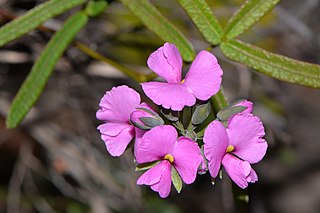
Grevillea endlicheriana, commonly known as spindly grevillea, is a species of flowering plant in the family Proteaceae and is endemic to the south-west of Western Australia. It is an erect shrub with linear leaves, and groups of white, pink tinged flowers.

Grevillea biternata is a species of flowering plant in the family Proteaceae and is endemic to the south-west of Western Australia. It is a shrub with divided leaves with linear lobes and clusters of white flowers.

Grevillea teretifolia, commonly known as round leaf grevillea, is species of flowering plant in the family Proteaceae and is endemic to the southwest of Western Australia. It is an erect to spreading shrub with many stems, divided leaves, the end lobes sharply pointed and more or less cylindrical, and clusters of white or pale pink flowers.

Isopogon heterophyllus is a plant in the family Proteaceae and is endemic to the southwest of Western Australia. It is a shrub with simple or pinnate, cylindrical leaves and hairy, usually pink flowers.
Dillwynia dillwynioides is a species of flowering plant in the family Fabaceae and is endemic to the south-west of Western Australia. It is a low-lying or erect, spindly shrub with cylindrical, grooved leaves and yellow, red or orange flowers with yellow, red or orange markings.

Pultenaea empetrifolia is a species of flowering plant in the family Fabaceae and is endemic to the south-west of Western Australia. It is a spindly, prostrate or spreading shrub with down-curved, cylindrical, grooved leaves and yellow to orange and red flowers.

Gompholobium burtonioides is a species of flowering plant in the family Fabaceae and is endemic to the south-west of Western Australia. It an ascending shrub that typically grows to a height of 15–45 cm (5.9–17.7 in) and flowers from September to December producing yellow, pea-like flowers. This species was first formally described in 1844 by Carl Meissner in Lehmann's Plantae Preissianae. The specific epithet (burtonioides) means "Burtonia-like".

Gompholobium knightianum is a species of flowering plant in the family Fabaceae and is endemic to the south-west of Western Australia. It is a slender, erect shrub with pinnate leaves, and mostly pink or purple, pea-like flowers.

Gompholobium ovatum is a species of flowering plant in the family Fabaceae and is endemic to the south-west of Western Australia. It is an erect or prostrate shrub with egg-shaped leaves and yellow and red to purple, pea-like flowers.

Gompholobium preissii is a species of flowering plant in the family Fabaceae and is endemic to the south-west of Western Australia. It is an erect shrub with pinnate leaves with five to fifteen leaflets, and yellow, red and orange, pea-like flowers.
Gompholobium pungens is a species of flowering plant in the family Fabaceae and is endemic to the south-west of Western Australia. It is an erect, openly-branched shrub with spiny stems, pinnate leaves and mostly yellow, pea-like flowers with pink or purple markings.
Gompholobium roseum is a species of flowering plant in the family Fabaceae and is endemic to the south-west of Western Australia. It is an erect shrub with pinnate leaves and yellow, pink or green, pea-like flowers with pink or green markings.
Gompholobium subulatum is a species of flowering plant in the pea family Fabaceae and is endemic to northern Australia. It is a slender, erect shrub with pinnate leaves with five to eleven leaflets, and uniformly yellow, pea-like flowers.

Gompholobium tomentosum, commonly known as hairy yellow pea, is a species of flowering plant in the pea family Fabaceae and is endemic to the south-west of Western Australia. It is an erect shrub with hairy foliage, pinnate leaves with five to seven leaflets, and uniformly yellow, pea-like flowers.

Gompholobium villosum is a species of flowering plant in the pea family Fabaceae and is endemic to the south-west of Western Australia. It is a slender, erect shrub with simple, needle-shaped leaves with one or two grooves on the lower surface, and violet, pink or purple flowers.
Gompholobium viscidulum is a species of flowering plant in the pea family Fabaceae and is endemic to the south-west of Western Australia. It is an erect shrub with pinnate leaves with five to seven leaflets, and yellow flowers.
Daviesia benthamii is a species of flowering plant in the family Fabaceae and is endemic to the west of Western Australia. It is an erect, bushy shrub with scattered, cylindrical, sharply pointed phyllodes, and yellow-orange and reddish-brown flowers.

Daviesia brachyphylla is a species of flowering plant in the family Fabaceae and is endemic to the south-west of Western Australia. It is a spreading to bushy shrub with cylindrical phyllodes with a slightly downcurved point and orange, maroon and red flowers.

Daviesia daphnoides is a species of flowering plant in the family Fabaceae and is endemic to the south-west of Western Australia. It is a bushy or spreading shrub with glabrous foliage, sharply-pointed narrow elliptic to egg-shaped phyllodes with the narrower end towards the base and yellow and dark red flowers.

Daviesia decurrens, commonly known as prickly bitter-pea, is a species of flowering plant in the family Fabaceae and is endemic to the south-west of Western Australia. It is spreading, erect, or low-lying shrub with scattered, sharply-pointed, narrow triangular phyllodes, and yellowish pink and velvety red flowers.














